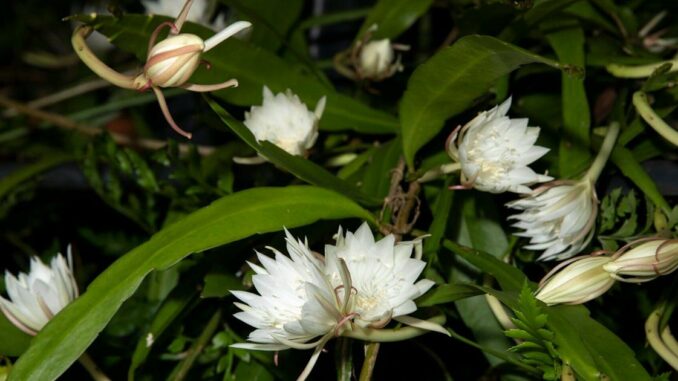
Garden columnist Dan Gill answers readers’ questions each week. To send a question, email Gill at gnogardening@agcenter.lsu.edu.
I have a night blooming cereus that is several years old and that has consistently produced beautiful flowers. It spends the winter in my sunroom. It now has four very long “spikes” 3 to 4 plus feet tall with roots growing out of them. Is this to be expected? The plant is in a hanging basket, which I suspend from a branch of a tree during the warmer seasons. As it grows larger, I don’t know how much longer I can keep it in this hanging basket. Should I chance planting it in the ground outdoors? — Mary Wallace
Night blooming cereus plants (Epiphyllum oxypetalum) produce two types of growth: flattened leaf-like stems and long, round stems. Both types of stems are normal for these plants. After the long, round, rod-like stems grow for a while, they stop. Eventually they send out the flattened leaf-like stems. You may feel free to prune either the flattened leaf-like stems or the round stems as you like, whenever you need to control the size and shape of the plant.
The night blooming cereus is not reliably winter hardy here, so we grow them in containers so we can protect them over the winter. Feel free to trim or prune the plant to maintain a manageable size in the hanging basket. The pieces you cut off can easily be rooted to share.
Garden tips
Although they may still be found for sale in big box stores, snapdragons are cool season plants that won’t survive the summer.
KNOW YOUR SEASON: Nurseries may still be offering some cool-season bedding plants for sale, but they are not the best choice if you want something that will last through the summer. If you aren’t sure whether a plant you are considering is heat tolerant, check with the staff about which bedding plants will peter out when summer heat arrives.
TIDYING BULBS: Remove faded flowers and developing seed pods from spring-flowering bulbs that are to be kept for bloom next year. Do not remove the green foliage. Wait until the foliage turns mostly yellow before you cut it back. Bulbs that reliably rebloom here do not need to be dug and can be left in the ground. Bulbs that rebloom well in our area include leucojum, many narcissuses and daffodils, Dutch iris, amaryllis, ground orchid (Bletilla), Easter lily, wood hyacinth, freesia, star flower (Ipheion), hyacinths (will rebloom but the spikes are much smaller), Louisiana irises, spider lilies (Hymenocallis) and calla lily (only Zantedeschia aethiopica). Many other bulbs, such as tulips, crocus, anemones, scilla and muscari, rarely will repeat bloom or will produce inferior flowers next year, and may be pulled up and discarded when they finish blooming.

Leave a Reply